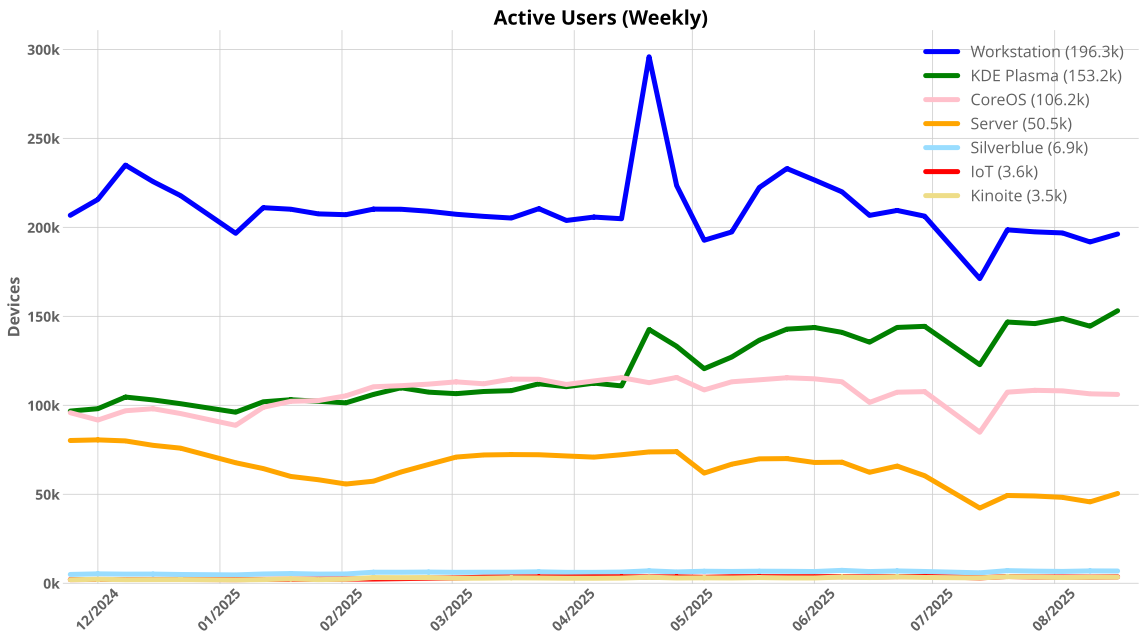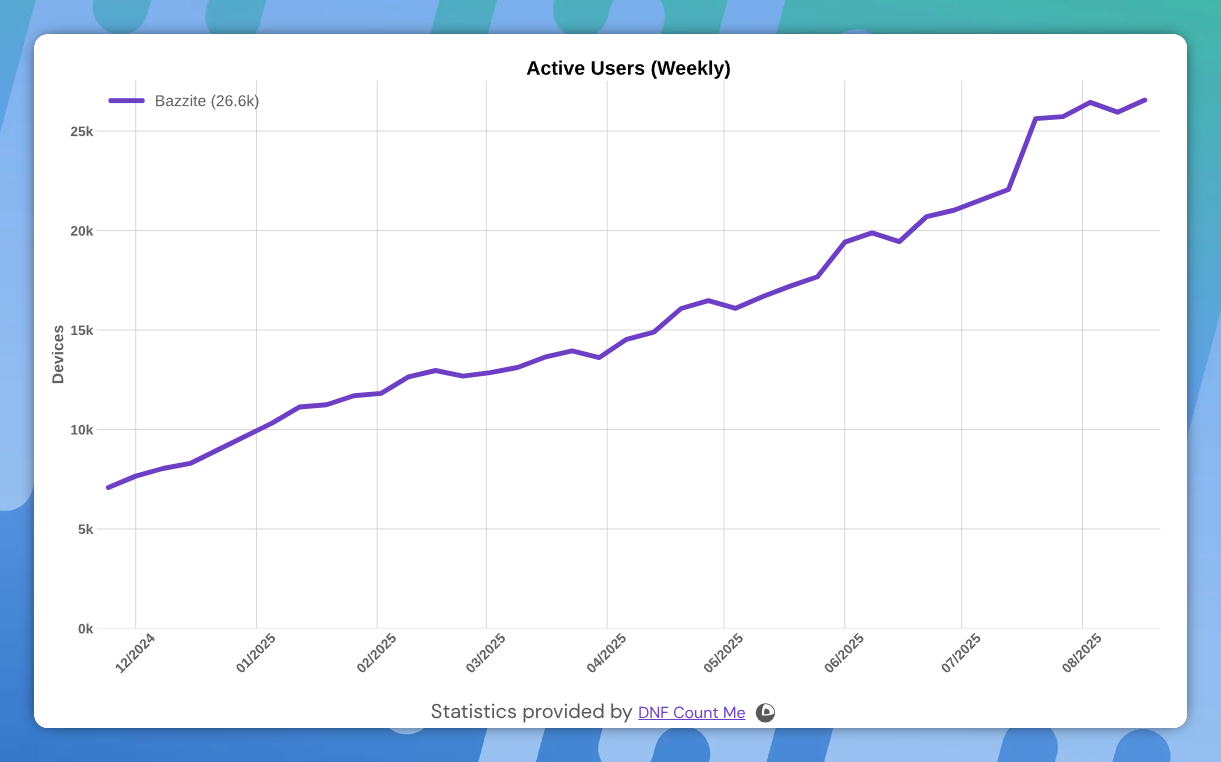Generated via https://github.com/ublue-os/countme
10k added users since last post. Here are upstream numbers only

Dude Fedora? Really
Just use Windows if you want a voyeur.
Call me a Luddite, but I want to retain control over my updates and upgrades. I fear the day that Fedora becomes all atomic, all the time, which I can’t help but think is in the cards
What’s stopping you from turning updates off?
Then what would be the point of using an atomic version?
Never really understood the appeal of “immutable” distros.
There’s not a single distro out there that does everything right and won’t require manually editing some fuckup on the developers’ part. Why would we want to make it harder for us when the time inevitably arises?
spoiler
I’m just assuming it’s because people are stupid and like to fit in with other idiots. The average computer user today definitely has difficulty thinking for themselves and making their own decisions, so whenever someone else comes along and tells them a different way of doing things, they immediately assume that person is right.
Go on and keep using your distro another few years, and you’ll recognize the patterns of what keeps breaking. And then try some others for some years, and you’ll find that you can at most pick between smaller issues on a regular base on rolling ones, or larger batches of issues on release based ones. And some point you’ll find that every user creating a custom mix of packages that are all interdependent on another is quite the mess, and the number of package combinations times the number of configuration option combinations is so large that you can guarantee some of them will have issues. On top you have package managers rumaging around in the system while it is in use, and with a mix of old code that is still loaded in ram and new code on disk behaviour for these transients is basically undefinded. Ultimately you’ll grow tired of this scheme at some point, and then running a byte-to-byte copy of something that has been tested and doing atomic updates is quite attractive. And putting a stronger focus on containerized applications not only enables immutable distros for broad adoption in the first place, but also cuts down the combinatorial complexity of the OS. And lastly, to be honest, after so many years of the same kinds of issues over and over again, the advent of immutable+atomic distros + containerized desktop apps brought a couple of new challenges that are more interesting for the time being…
I am a container evangelist, I find excuses to convert my jobs into Kubernetes workloads, and I frequently use the likes of podman for one off apps/processes and development. I use Flatpak frequently to isolate dependencies for the likes of Steam and Heroic.
I really wanted to like Bazzite or Bluefin, but I can’t deal with the overhead from the rpm os-tree updates. I would frequently notice hitches for my use case (sunshine streaming), and the hoops I had to do to configure Nvidia drivers (for it to then not work as good as other distros) was tiresome.
I went back to Arch (EndeavourOS), and I improved sunshine performance and had a driver that worked with less fiddling.
I’m saying all this because, while I’m glad to see any Linux distro grow, I hope it starts delivering what it says on the tin eventually without compromises that I experienced. Markering on it being immutable and container focused is true, but I dont see the benefit (aside from more stability which as others pointed out, is already stable is most cases)?. Right now, its a simple to configure (assuming most defaults work for your setup) distro that is finding a growing niche amongst some users (obviously by the data shown). And thats good enough for now at least.
The removal of KDE Discover has me considering going back to plain Kinoite on my HTPC. I figure I can build a sysext with the handful of bazzite bits I actually use and keep the unbutchered plasma experience
Would you be willing to say more about what you know / experienced about the removal of Discover? Preferences included? I only noticed it recently, been away from things for a bit, and you sound like your brief info would probably be at least as fruitful as the reading I was gonna look for :)
the ublue project / bazzite decided to make their own flatpak first app store called Bazaar. Fair enough its their distro. However they created it with GTK4/Adwaita libraries, so its a Gnome native app and looks completely ugly on a KDE Plasma desktop. Also as a flatpak first app store it doesn’t update anything else on your machine like what discover is capable of (cant update ostree, knew stuff etc). This means you have to use the ujust terminal app to access updates, which I dont agree with.
I think technically you could layer it back in with rpm-ostree install kdediscover - however this pulls back a couple of hundred meg of plasma dependencies, which if you’re not aware, when you update your system would be redownloaded and reinstalled with each new ostree snapshot, slowing down the update process even further. I I tried doing it as a sysext (myrepo) but it keeps segfaulting and I havent worked out the issue. Sysexts are new experienmental alternative to package layering which hold a lot of potential (check out tim ravier’s development of them here https://travier.github.io/fedora-sysexts/)
You don’t use the terminal to do updates, updates are automatic by default.
We also completely removed discovers ability to update OSTree. It’s never been present in a single build of Bazzite.
This is why I don’t pay attention to people that complain about toolkits. You don’t like the way it looks so you make up absolutely disingenuous points to argue about it.
I also said ublue is free to do what they want, why are you attacking me for suggesting I want to put something back the way it was? I never asked for your attention, I’m not pestering the developers about it, instead I attempted to author a fix for anyone who also is not a fan of the change.
Yes, I dont like a core system tool not being part of my desktop, I dont want my updates to fire via a timer, and I have updated my ostree via discover on my bazzite box. I understand a lot of your target audience does want those things, an appliance type experience - I even suggested 2 posts up that perhaps bazzite was no longer for me as the target audience.
I appologise for drawing your ire
I also said ublue is free to do what they want
Thank the lord we have your permission
There’s a toggle for the store in ujust command iirc
Only on Aurora, we don’t ship that.
I couldnt see one - I also dont want to layer it, because it will pull in a couple of hundred megs of kde dependencies every time you update. I tried doing it as a sysext (myrepo) but it keeps segfaulting and I havent worked out the issue
Sysexts are something I’ve been meaning to get in to. Have you had much success in general with them?
Yes I use Kinoite as my work machine and I’ve used Tim Ravier’s sysext repo for adding libvirtd, distrobox, wireshark and vscode to that machine. I also authored my own that adds nmap, iperf, telnet, screen and a few other command line tools I make use of at work. I find this easier than juggling toolboxes for it
Lots of shit-talking Bazzite…
I don’t game much but when I do it’s on Fedora.
What distro do you all recommend for my Windows buddy looking to switch to gaming on Linux?
CachyOS might be the easiest one that gives you something decent. It’s basically an Arch Linux with slightly better compiler optimizations and tweaked kernels. Also a tweaked version of proton in the core repos.
Started by a German dude so EU++ or something. And of course it’s based on Arch Linux, which was started by a Canadian dude.
It’s on top of distrowatch too, but I have no idea what that implies.
Easy installer too.
People just don’t like it because it’s different and uses new tech
Manjaro is the closest thing to Windows you’re going to get.
I recommend it with KDE.
Because it sucks? 🙃
Like, seriously, Manjaro had so many problems already that were completely preventable, makes stupid mistakes, bloats itself up with nonsense and provides no stability improvement over Arch whatsoever (which is a bad thing). On the contrary, it apparently even introduces additional bugs.
I’m not surprised they accidentally DDoS’ed the AUR, given they also have a docker script that spins up every single time an image is downloaded to push a change to git to increment a counter. Every. Single. Time. A full docker container. From scratch.
I’d only ever recommend Manjaro to people I really don’t like.
Please. Get a life.
lol
You’re doing a good job fitting in with your peers.
Mission accomplished.
Manjaro has also DDoS’d the AUR several times and is known for not keeping their certs up to date.
Say no to manjaro https://github.com/arindas/manjarno
sigh… Stop beating a dead horse. I’ve been using Manjaro since 2022 with absolutely no problems.
Get over it!
Nice automated response. Pretty sure that hasn’t been an issue for years.
Linux Mint’s website was hacked and they served a malicious ISO, but the useful idiot crowd never talks about that.
The snowball effect is real, and if you can’t see it then you’re probably a part of it.
The main reason why people hate on Manjaro is because it makes it easy to use a historically complicated distro. Anyone rational person who has been in the free software ecosystem for a substantial period of time will recognize that there are many morons, elitists, and losers who like to make things more complicated than they need to be to feel superior to others.
Also, people don’t like when another distro is better than theirs, which Manjaro is for the vast majority of rational users.
No one hates endeavouros yet it makes arch Linux easy to use. I don’t see why endevouros isn’t the better choice over manjaro.
PopOS/Cosmis has native Nvidia support, works perfectly out of the box
Bazzite is the option for Windows converts that want a gaming focused Linux desktop. A lot of people are going to nitpick it to death, because they want “Literally Windows but without Microsoft”. Which isn’t happening while Linux has the market share it has. You either accept a few minor annoyances (while advocating for those annoyances to be fixed), or go back to Windows and accept Microsoft’s authoritarian control of your computer.
Bazzite is a solid desktop that’s going to be really hard for a regular user to break, comes with Steam, Lutris, and Heroic built in, proprietary nvidia drivers installed, and is based on Fedora (Modern, stable, well supported).
The only downside is KDE can be really easy to break if you’re a new user unfamiliar with how customizing it works, but if you leave it default you’re fine.
My son also picked Bazzite, which I hadn’t heard of before. Unfortunately he didn’t like it and it back to Windows again.
Any chance he’s willing to try another distro? Linux Mint maybe?
I guess his son picked Bazzite for gaming. Linux Mint would not help with that since it’s lagging behind in updates to drivers (Mesa, etc)
I did recommend Mint (although I use EndeavourOS myself), but he’s not interested anymore.
It probably didn’t help that I recently recommended him to buy Nvidia rather than AMD for a recent upgrade, because Nvidia had lower power requirements, and I don’t his his PSU would have been able to handle the comparable AMD.
Surprised to see it at the bottom of the graph, but for anyone with a homelab uCore is a present from the
heavenscloud!Just installed it at the start of the month on an older PC for a console-like experience in my living room. Only 2 issues really have me disappointed (and I’m not sure there’s much Bazzite can do about them)
-
No HDMI 2.1 support from my AMD card (like seriously, wtf? Had I known that I probably would have dropped a 9060 XT in instead of a 9070XT)
-
No real wake in controller support for my FlyDigi or Xbox Series controllers. I’ve messed around in udev and found no solutions.
If they can figure those things out, I’d be much more impressed with the experience…. For now it just feels like another FOSS compromise to the product you actually want (PS5 Pro)
Unfortunately, the former is not possible due to asinine requirements by the HDMI Forum: https://www.phoronix.com/news/HDMI-2.1-OSS-Rejected The only option is to use DisplayPort instead (or perhaps an adapter).
Unfortunately, my living room TV has only HDMI in, no DP. I tried the adaptor route, but it was horribly unstable… sometimes providing perfect signal, sometimes cutting to a black screen for a second or 2, every 5-10 seconds. Either way, VRR is wholly unsupported by the adaptor.
Unfortunately nothing that can be done about it unless someome creates an “illegal” kernel module which supports HDMI 2.1 despite the lack of license. That’s basically the only hope right now (and I’m all for it).
-
Bazzite community really deserves tbe credit. Lots of work and great vibes all around!
I will hypothesize why:
Bazzite is the Trendy Distro Of The Month, like Peppermint or Endeavor or Nobara or a frillion others. CachyOS is apparently next. Nearly constantly, you’ll hear about some trendy new distro which is a fork of Ubuntu or Fedora or Arch that has a feature or two targeted at newcomers or gamers, and for awhile it gets heavily recommended on Reddit or Lemmy, then you stop hearing about it forever as the rest of the ecosystem adopts that feature or fixes the thing that feature was meant to be worked around, and then the cycle repeats.
Bazzite is targeted toward gamers, it emphasizes a solid onboarding experience with a configurator to choose/build your install media based on what you want to do with it, do you want a handheld or home theater experience or a keyboard and mouse desktop? Do you want it to boot to SteamOS or to a DE? Which DE? What hardware do you have? So their gimmick is to steer users through the initital config and setup process. Which as gimmicks go, that one is pretty solid.
MEANWHILE
Fedora’s Atomic editions have no gimmicks at all. You have to independently learn that immutable distros exist, independently decide you want that, and then go hunting on their website through their godforsaken marketing wank to find it.
Fedora likes their bullshit branding. You go to their website, and there are big buttons for Fedora Workstation right next to Fedora KDE Plasma Desktop. “Workstation” does not mention that it’s just the Gnome version. You have to stroll further down, past server, IoT and “Core” versions, to a section that looks visually different labeled “More Fedora Options” including Atomic and Spins. You’re a new Linux user, you’ve just used the OS that came with your computer your whole life, explain to me what the difference between Core and Atomic is and why you should choose one over the other?
The Atomic versions, which is kind of a synonym for “immutable”, you click on that, and you’re presented with five options: Fedora Silverblue, Fedora Kinoite, Fedora Sway Atomic, Fedora Budgie Atomic, and Fedora Cosmic Atomic Nowhere in its name or description does Silverblue mention that it’s the Gnome desktop one. Kinoite starts with a K and also mentions in the description it’s the KDE atomic version. Also, “kinoite” is a godawful word, they should have gone with Kyanite instead, which is a different blue crystal. Or they should have just called it KDE Atomic or Plasma Atomic. The others just put the DE’s name in the title LIKE A NORMAL PERSON, ROWAN.
That’s a really dismissive way to say “It’s an OS built to fit a demand that wasn’t being met by the other distros”.
I am wary about invoking Apple here, but say what you will about the company, there’s a lot of value in a braindead setup process. Many, many users just want something that just works - it was literally something I asked for when Linux was recommended to me (knowing some hate Ubuntu, I’ll out myself: using Ubuntu Budgie - setup was super simple. I guess there must be demand for that niche in the broader Linux community, so that’s a very smart move by Bazzite.
CachyOS is apparently next.
I’d argue that this is already the current trend. I can’t count the number of random Indian youtubers I recently got recommended to watch as they glaze CachyOS as the second coming of christ.
Bazzite just works when it’s a regular desktop. The HTPC (with steam game mode) one has a major issue that I don’t see them even addressing, it doesn’t suspend. It goes into a permanent black screen and the PC is still running. Nothing revives it beside a forced reboot. I reported it to their GitHub and got nothing really. I thought it was my hardware, but I had a friend of mine bring his whole tower to my house, we installed bazzite and it did the same thing. His tower has all new AMD hardware. On my laptop, bazzite is solid as hell. Works with zero issues.
It works very nicely on my legion go.
Ubuntu used to be one of the best gaming desktops that was still very stable and usable for everything else, but Canonical has been ruining it to make it more aimed at business and making more ways to profit, so Fedora has been filling the gap IMHO. Still some better dedicated gaming build distros, but Bazzite is good at being a gaming distro that works well as a productivity desktop too.
Ubuntu literally has never in it’s history been a good gaming distro. It use to just be a popular one. But all of the Deb/apt distros have never been “good choices”
Arch and Gentoo were always the better options. And it’s really only recently that the rest become reasonable options.
Gaming has historically been best on absolutely bleeding edge distros with a bunch of hacky community patches and fixes.
Gaming really benefits from up to date kernels. So Ubuntu just isn’t a good choice for that.
I don’t think Ubuntu is ruined so much as that Bazzite is very focused on the gaming use case and is a better choice if that’s what you want to do. I use Ubuntu and have tried Bazzite (in a VM with an Nvidia GPU pass thru). Bazzite made the Nvidia based install incredibly easy, and is a particularly good choice for VFIO. I personally use Ubuntu specifically because it’s the same OS as my cloud servers. They solve real problems in that space.
Bazzite is not growing because it’s immutable.
Angry upvote.
?

Bazzite’s growth is not because it is immutable, Bazzite’s growth is because it offers gamers a straightforward onboarding process.
It offers a straightforward onboarding process because it’s image based. The model is part of the success.
The upward trend is not because Bazzite is immutable.
I disagree with you fundamentally, if it wasn’t for the simple updates and stability this would not have the success that it does. The image is part of the model.
lol you’re confusing me, bazzite isn’t immutable. Do you mean to say “Bazzite is growing for other reasons?”
Wut? You’re responding to a trend graph for Fedora’s immutable (Atomic) forks.
Built on Fedora’s rpm-ostree system, Bazzite uses an immutable design with atomic updates and rollback functionality.
https://en.m.wikipedia.org/wiki/Bazzite_(operating_system)
But yes, since the trend chart is showing immutable distros and how Bazzite is growing, I am saying the fact that Bazzite is immutable has nothing to do with it’s growth.
Edit: Reading again, I realize you might not know that Fedora Atomic is the immutable base. 😉
The Bazzite team doesn’t control the wikipedia page, just the official documentation. Someone made up the term “immutable design”, that’s not a thing it’s just a container. There’s no need to confuse people just call it bazzite or a container. Atomic is a fedora brand name, it’s not a thing to classify things under.
As you can see from the comments in the thread all this does is confuse people.
Source: I work on bazzite
“Immutable”: A term to describe Linux operating systems that do not follow the traditional filesystem layout where every single file can be removed by the user with root privileges. It is more nuanced than this in the case of Bazzite, but is still considered “immutable” from the point of view of the extended Linux community. The Bazzite team would not describe Bazzite as an “immutable” operating system.
https://docs.bazzite.gg/General/terms/
I’m a big fan of Bazzite, but as stated in the docs, “immutable” is a term the community uses to describe it.
Education is the key to reducing confusion, not pretending a system architecture doesn’t exist or matter.
After reading this I’m confused about what immutable means
Bazzite contributor here, there’s no reason to care about this. This term just confuses people you can safely ignore it.
Pretend your running a live OS off a read-only USB, yet any changes (app installs, config changes, etc) you make are saved to the HD. A new version of the OS comes out, so you write a new ISO to your USB, and upon booting it, all you changes are applied on top.
This is a simplistic view of immutable distros, but thwy wrk more like snapshots. It allows for rollback. So you install v1, then v2 is a newer snapshot of the base OS, v3 is another, always building.
The catch is they often require apps to run under things like flatpak so you don’t have to alter the OS packages. Personally, I’m not a fan for a daily driver, but it’s great for distros like Bazzite.
👑 the goat is here
They all are
But “being immutable” is not why Bazzite is growing.
I am interested in Bazzite, but am unsure about its compatibility with NVIDIA GPUs. Had anyone here had experience with this?
20XX onwards in desktop version is fine. I’ve only heard issues when using gaming mode on the HTPC version, and even then i think it’s just inside the gamescope steam menu it’s shit, in games it’s just fine, no difference.
Worked great in VM with Nvidia A4000. Zero problems, just a learning curve to use
rpm-ostreeandbrewinstead ofdnf.You should not be using rpm-os tree as a replacement for DNF. Their docs have a software installation section that specifically state it should be avoided.
Thanks for the advice but unfortunately I don’t read documentation.
I use a Fedora variant called Nobara with my 4080. Driver management has been great.
Works fine, but there are a few issues with game mode specifically.
It handled it like a pro for me
Works fine with the nvidia open drivers, what gpu you got
The open drivers ? You mean the ones without 3d acceleration support ?
That’s not the case for the newer open source drivers from nvidia. They’re only compatible with the last few generations of cards but they’re performant and the only feature they lack is CUDA to my knowledge. Not talking nouveau here
Oh ok, that’s pretty good then.
But I do hope we’ll get an open cuda replacement soon and some sort of gpu partitionning/ vgpu capabilitycuda works fine on 4070 right now, though iirc certain specific things dont run well and are a little funky in comparison
🤷♀️ I don’t know much about that, cyberpunk runs perfect on my 4070 idk what else you could want
Then you are surely running the proprietary nvidia drivers, not the open source “nouveau” nvidia drivers ?
“nouveau” != “Nvidia open source drivers”. Nouveau was community made by reverse engineering. Nvidia has released their own open source drivers now.
thanks, this explains my confusion, I recently lost half a weekend to this distinction !
Geforce GTX 1080
I run bazzite on an old laptop with a 1050, runs flawless.
I’m rolling a 1080 on Bazzite and it’s worked great for me, as well as NVIDIA does on Linux generally. Which is to say, much better than it was 2+ years ago but still could do with some improvements.
Same here also on a 1080, but with the closed-source drivers. There’s some issue they’ve had for at least the 6ish months I’ve been using it where with my dual screen setup sometimes hangs. Apparently it’s a known bug and they haven’t fixed it. It hits me about once every couple of weeks these days. Other than that it has run every game I’ve tried as well as Windows.
Ah yeah, I know the one you mean. It seems to be intermittently fixed but I’ve just rolled-back when it causes issues.
It seems better now than it was a few months ago. Back then it actually locked up my machine if I triggered the bug. Now it just temporarily slows things down.
But, I haven’t gambled on running a few apps that would regularly trigger it just in case. What’s funny is that modern Steam games are no problem, but it’s running emulated games using Emulation Station that causes problems. Games from 2024, no problem. Games from 1984? Hey, that’s pushing it.
Emulation is a hell of a drug…
That’s promising to hear! For the drivers are you using Open GPU?
I still have to look into the 1080s compatibility with this. Thanks OP for mentioning it.
Bazzite has a build for the older proprietary nvidia drivers, I’m pretty sure 1080s dont get the open source variant of the driver unfortunately 😔
https://github.com/NVIDIA/open-gpu-kernel-modules
https://download.bazzite.gg/bazzite-nvidia-stable-amd64.iso this is the download for the proprietary nvidia kde iso
https://download.bazzite.gg/bazzite-gnome-nvidia-stable-amd64.iso this one is for gnome
I don’t know how well the proprietary driver runs, I assume if you got it running on another linux distro this will work fine
Thanks! I am still very new to Linux and have been learning the OS through OpenSUSE on an old laptop. Still debating which Linux distro to switch to for the windows desktop (the one with the 1080)
Could try dual booting to see how your hardware works

















